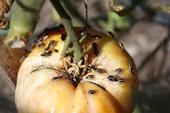![Foliage damaged by peach leaf curl. [Photo by J.K. Clark]](https://ucanr.edu/blogs/UCIPMurbanpests/blogfiles/26254small.jpg)
Winter is a key time for gardeners to take preventive actions against peach leaf curl in some areas in California. Caused by the fungus Taphrina deformans, peach leaf curl causes distortion, thickening, and reddening of foliage as peach and nectarine trees leaf out in the spring. Damaged leaves often die and drop, but they will be replaced with new, healthier leaves once the weather turns dry and warm. An untreated leaf curl infection will contribute to a tree's decline over several years.
To prevent peach leaf curl in areas where the disease occurs, treat susceptible trees with preventive fungicides during the dormant season, ideally in late November or December. A second application should...
![Male western fence lizard. [Photo by J.K. Clark]](https://ucanr.edu/blogs/UCIPMurbanpests/blogfiles/25911small.jpg)
Although some lizards eat plants, most lizards feed on insects. In California, the most common types feed on beetles, ants, wasps, aphids, grasshoppers, and spiders. Lizards cause no measurable damage to plants in gardens and may be beneficial by eating pest insects and should be left alone.
Occasionally, however, lizards can enter homes and buildings through small openings, especially gaps beneath doors. They are excellent climbers so they can enter at any structural opening 1/4 inch or larger. Should a lizard enter your home, there are several ways to capture and release it outdoors.
Find out more about how to keep lizards out of your house in our recently updated Pest Note
- Author: Karey Windbiel-Rojas
![Mature female western black widow spider. [Photo by R. Vetter]](https://ucanr.edu/blogs/UCIPMurbanpests/blogfiles/25754small.jpg)
Halloween is the perfect time to talk about some of the creepy, crawlies that scare people the most: Spiders.
Many people think that all spiders are dangerous, scary, and aggressive. Most spiders are harmless and serve a beneficial role by catching and killing pest insects.
There are many different types of spiders inhabiting homes and gardens. In California, the main spider capable of causing serious injury is the black widow, which generally remains outdoors and out of sight. Spiders seen out in the open during the day are unlikely to bite people.
The UC Statewide IPM Program has lots of information to help you identify
![Black cutworm larva in turfgrass. [Photo by J.K. Clark]](https://ucanr.edu/blogs/UCIPMurbanpests/blogfiles/25642small.jpg)
Contrary to popular belief, insects are not a common cause of residential lawn damage in California, Lack of proper cultural care and use of inappropriate grass species in a particular location are much more likely to cause unhealthy or dying lawns than insects.
However, certain insects may occasionally damage or kill turfgrass. Insect feeding can cause grass to turn yellow or brown or die, especially if the grass is already stressed. Damage usually begins in small, scattered patches, which may merge into large dead areas. Insects that may cause damage in California lawns include various root-, crown-, and leaf-feeding caterpillars; grubs, which include the larvae of scarab beetles such as the black turfgrass ataenius and...
- Author: Surendra Dara
- Editor: Karey Windbiel-Rojas

The Bagrada bug (Bagrada hilaris) is an invasive stink bug insect that was first reported in 2008 in Los Angeles County, California. It has now spread to several counties in California and is moving northward in the state. Bagrada bug is also spreading eastwards from California and is currently reported in Nevada, Arizona, Utah, New Mexico, and Texas.
Distribution: Citizen scientists have been instrumental in reporting the occurrence of Bagrada in various counties and are helping map its current distribution. As of September 2014, Bagrada bug is known to be present in Imperial, San Diego, Orange, Riverside, Los Angeles, San Bernardino, Kern, Kings, Inyo, Fresno, Merced,...


